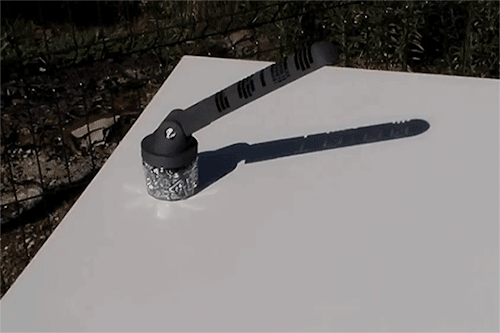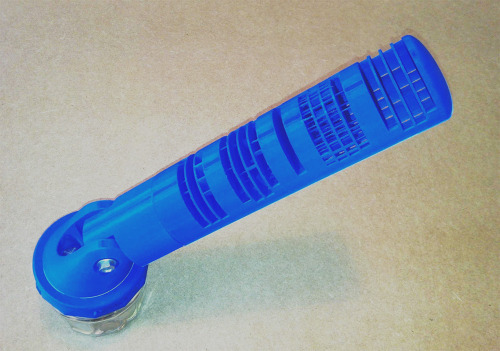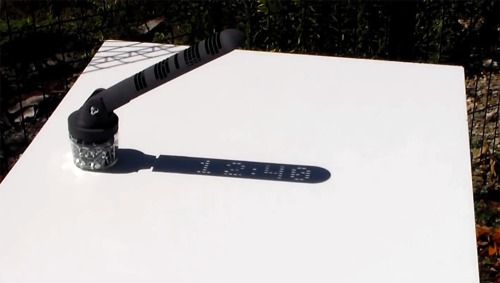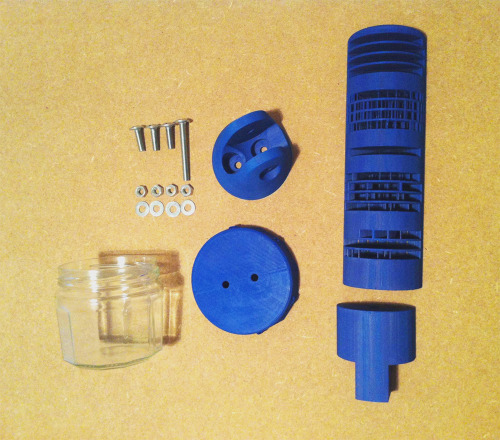A Group Of Astronomers Is Using A New Method To Search For Hard To Spot Alien Planets: By Measuring The

A group of astronomers is using a new method to search for hard to spot alien planets: By measuring the difference between the amount of light coming from the planets’ daysides and nightsides, astronomers have spotted 60 new worlds thus far.
Continue Reading.
More Posts from Science-is-magical and Others


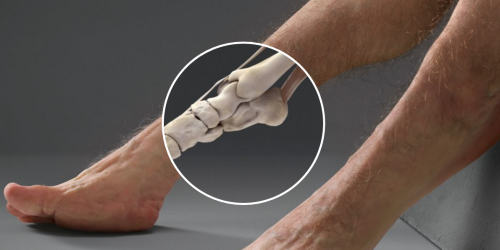
Here’s how nightmarish humans would look if our bodies were designed to survive car crashes
Article by Chris Weller, Tech Insider & Business Insider
If you’re ever in a car with Graham, then don’t bother telling him to buckle his seat belt. His body is already designed to withstand high-speed impacts.
Designed by a trauma surgeon, an artist, and a crash investigator, Graham is a hypothetical scenario come to life. Supported by Australia’s Transport Accident Commission, the project is meant to highlight how vulnerable humans are to injury.
Graham, however, is not.
Keep reading

i’m proud of them


ALL ROLLED UP
A newly identified mineral christened merelaniite tightly rolls up like a scroll as it crystallizes, forming shiny dark gray needles up to a few millimeters in length (Minerals 2016, DOI: 10.3390/min6040115). The overall formula of the mineral is Mo₄Pb₄VSbS₁₅. It crystallizes into a sheet composed primarily of alternating ultrathin layers of MoS₂ and PbS. “It’s like a natural nanocomposite,” says research team leader John A. Jaszczak of Michigan Technological University. Strain from the interacting layers likely causes the crystalline sheets to wrap around themselves as they grow. Jaszczak and coworkers named the mineral for the Merelani mining district in Tanzania, where the merelaniite samples originated. Collaborating research institutions included the U.K. Natural History Museum, U.S. National Museum of Natural History, and University of Florence.
Credit: Minerals (both)
Related C&EN content:
Minerals in Medicine Exhibition
Worldwide Hunt For Missing Carbon Minerals Begins

It often seems so quiet after a snowfall because the fresh powder absorbs sound waves. As the snow melts and freezes, it then creates a reflective surface that allows sound to travel farther than normal. Source
hey guys i think i got a pretty nice tan over the summer, what do you think?
before:

after:


After the Battle of Shiloh in 1862, many Civil War soldiers’ lives were saved by a phenomenon called ‘Angel’s Glow.’ The soldiers, who lay in the mud for two rainy days, had wounds that began to glow in the dark and heal unusually fast. In 2001, 2 teens won an international science fair by discovering the soldiers had been so cold that their bodies created the perfect conditions for growing a bioluminescent bacteria, which ultimately destroyed the bad bacteria that could’ve killed them. Source Source 2 Source 3
Newly discovered windows of brain plasticity may help with treatment of stress-related disorders
Chronic stress can lead to changes in neural circuitry that leave the brain trapped in states of anxiety and depression. But even under repeated stress, brief opportunities for recovery can open up, according to new research at The Rockefeller University.

(Image caption: Routine versus disruptive: A familiar stressor (left) did not increase NMDA receptors (dark spots), a booster of potentially harmful glutamate signaling, in the brains of mice. However, when subjected to an unfamiliar stress (right), mice expressed more NMDA receptors)
“Even after a long period of chronic stress, the brain retains the ability to change and adapt. In experiments with mice, we discovered the mechanism that alters expression of key glutamate-controlling genes to make windows of stress-related neuroplasticity—and potential recovery—possible,” says senior author Bruce McEwen, Alfred E. Mirsky Professor, and head of the Harold and Margaret Milliken Hatch Laboratory of Neuroendocrinology. Glutamate is a chemical signal implicated in stress-related disorders, including depression.
“This sensitive window could provide an opportunity for treatment, when the brain is most responsive to efforts to restore neural circuitry in the affected areas,” he adds.
The team, including McEwen and first author Carla Nasca, wanted to know how a history of stress could alter the brain’s response to further stress. To find out, they accustomed mice to a daily experience they dislike, confinement in a small space for a short period. On the 22nd day, they introduced some of those mice to a new stressor; others received the now-familiar confinement.
Then, the researchers tested both groups for anxiety- or depression-like behaviors. A telling split emerged: Mice tested shortly after the receiving the familiar stressor showed fewer of those behaviors; meanwhile those given the unfamiliar stressor, displayed more. The difference was transitory, however; by 24 hours after the final stressor, the behavioral improvements seen in half of the mice had disappeared.
Molecular analyses revealed a parallel fluctuation in a part of the hippocampus, a brain region involved in the stress response. A key molecule, mGlu2, which tamps down the release of the neurotransmitter glutamate, increased temporarily in mice subjected to the familiar confinement stress. Meanwhile, a molecular glutamate booster, NMDA, increased in other mice that experienced the unfamiliar stressor. In stress-related disorders, excessive glutamate causes harmful structural changes in the brain.
The researchers also identified the molecule regulating the regulator, an enzyme called P300. By adding chemical groups to proteins known as histones, which give support and structure to DNA, P300 increases expression of mGlu2, they found.
In other experiments, they looked at mice genetically engineered to carry a genetic variant associated with development of depression and other stress-related disorders in humans, and present in 33 percent of the population.
“Here again, in experiments relevant to humans, we saw the same window of plasticity, with the same up-then-down fluctuations in mGlu2 and P300 in the hippocampus,” Nasca says. “This result suggests we can take advantage of these windows of plasticity through treatments, including the next generation of drugs, such as acetyl carnitine, that target mGlu2—not to ‘roll back the clock’ but rather to change the trajectory of such brain plasticity toward more positive directions.”
-
 djsubatomic reblogged this · 4 years ago
djsubatomic reblogged this · 4 years ago -
 gerten-blog1 liked this · 6 years ago
gerten-blog1 liked this · 6 years ago -
 chaoticconnoisseurgiver reblogged this · 6 years ago
chaoticconnoisseurgiver reblogged this · 6 years ago -
 chaoticconnoisseurgiver liked this · 6 years ago
chaoticconnoisseurgiver liked this · 6 years ago -
 anewbeginningglobal liked this · 6 years ago
anewbeginningglobal liked this · 6 years ago -
 generalblazeavenue liked this · 6 years ago
generalblazeavenue liked this · 6 years ago -
 replicant1955 liked this · 6 years ago
replicant1955 liked this · 6 years ago -
 spyderspic666 liked this · 6 years ago
spyderspic666 liked this · 6 years ago -
 science-is-magical reblogged this · 7 years ago
science-is-magical reblogged this · 7 years ago -
 lafillemortedelalune-blog liked this · 7 years ago
lafillemortedelalune-blog liked this · 7 years ago -
 shi1498912 reblogged this · 7 years ago
shi1498912 reblogged this · 7 years ago -
 docteurpeluche-blog liked this · 7 years ago
docteurpeluche-blog liked this · 7 years ago -
 robermen1980 liked this · 7 years ago
robermen1980 liked this · 7 years ago -
 charlezsltz liked this · 7 years ago
charlezsltz liked this · 7 years ago -
 sealpai liked this · 7 years ago
sealpai liked this · 7 years ago -
 last-flight-of-dickarus reblogged this · 7 years ago
last-flight-of-dickarus reblogged this · 7 years ago -
 last-flight-of-dickarus liked this · 7 years ago
last-flight-of-dickarus liked this · 7 years ago -
 thepajmahal reblogged this · 7 years ago
thepajmahal reblogged this · 7 years ago -
 thepajmahal liked this · 7 years ago
thepajmahal liked this · 7 years ago -
 jonyewest liked this · 7 years ago
jonyewest liked this · 7 years ago -
 temple-of-floraa reblogged this · 7 years ago
temple-of-floraa reblogged this · 7 years ago -
 purenenaas reblogged this · 7 years ago
purenenaas reblogged this · 7 years ago -
 keven7aa liked this · 7 years ago
keven7aa liked this · 7 years ago -
 cosmic-being86 liked this · 7 years ago
cosmic-being86 liked this · 7 years ago -
 fangirl570 reblogged this · 7 years ago
fangirl570 reblogged this · 7 years ago -
 bachatanero liked this · 7 years ago
bachatanero liked this · 7 years ago -
 thestarninja liked this · 7 years ago
thestarninja liked this · 7 years ago -
 birdsbirds1 liked this · 7 years ago
birdsbirds1 liked this · 7 years ago -
 j1o0s6i2-blog liked this · 7 years ago
j1o0s6i2-blog liked this · 7 years ago -
 littlefireflake liked this · 7 years ago
littlefireflake liked this · 7 years ago -
 sampimeh liked this · 7 years ago
sampimeh liked this · 7 years ago -
 alienated-by-society-blog1 reblogged this · 7 years ago
alienated-by-society-blog1 reblogged this · 7 years ago -
 sahrabarik-blog1 reblogged this · 7 years ago
sahrabarik-blog1 reblogged this · 7 years ago -
 davyhon liked this · 7 years ago
davyhon liked this · 7 years ago -
 pornandrugs liked this · 7 years ago
pornandrugs liked this · 7 years ago -
 deziac reblogged this · 7 years ago
deziac reblogged this · 7 years ago -
 profdavem liked this · 7 years ago
profdavem liked this · 7 years ago -
 tisitheone liked this · 7 years ago
tisitheone liked this · 7 years ago

